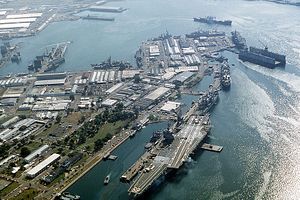The Philippines announced on Friday that Washington has accepted its draft for a new agreement granting the U.S. military greater access to bases in the Southeast Asia country.
In a press conference on Friday, Undersecretary of Defense Pio Lorenzo Batino said that consensus has been reached and just the final details are being hammered out. “Consensus was arrived at on many provisions of the draft agreement,” Batino said according to Reuters, adding that the deal was 80 percent done.
The Philippine Inquirer summarized Batino as saying that the “U.S. had accepted the Philippine draft of the proposed Agreement on Enhanced Defense Cooperation.” It went on to quote him as explaining that the draft “more comprehensively articulated the Philippines’ positions, notably its consistency with the Philippine Constitution and relevant laws, as well as mindfulness of the country’s historical experiences.”
Manila has greatly limited the U.S. military’s operations in the Philippines since kicking it out of Subic Bay—the headquarters of the 7th Fleet at the time—in 1992. For the most part, Washington’s been limited to assisting in counterterrorism operations in the Philippines, and only then since 9/11. However, Manila’s rising tensions with China over parts of the South China Sea has renewed its interest in granting the U.S. military greater access to bases like Subic Bay.
The two sides have long been negotiating the new terms of the access that the U.S. military will receive. The apparent breakthrough came during the bilateral strategic dialogue the two sides held in Washington, DC last week. The two sides are looking to finalize the agreement in time for President Barack Obama’s trip to the Philippines next month. Batino said during the press conference on Friday that the deal will not have to be ratified by the Philippine Senate, where it likely would have encountered stiff opposition from some factions.
Citing a “a military official with knowledge of the negotiations,” Reuters reported the terms of the current draft as granting the U.S. joint use of military facilities like Manila, Clark, Palawan, Cebu, Nueva Ecija, and La Union. However, according to this military official—whose nationality was not entirely clear—the Philippines is refusing to grant Washington access to civilian airfields and bases, most notably Subic Bay.
Still, China will almost certainly strongly protest the deal given that it views the U.S. pivot as designed to encircle and contain it. As I and many others have argued repeatedly, China has no one but itself to blame for the Philippines’ new willingness to welcome back the U.S. military. Far more than other South China Sea claimants, Beijing has targeted the Philippines relentlessly in recent years, including ejecting it from the Scarborough Shoal.
As I previously reported, just this week China has been blockading civilian vessels trying to bring supplies to Filipino Marines stationed on the Second Thomas Shoal. So far, Manila has been breaking this blockade by airlifting supplies to the Marines, instead of transporting them by sea.

































